SOLO TRIPPING IN A VERY RESPONSIVE PACKAGE
Right up front, I’m going to give a full tip o’ the cap to John Winters, Canadian boat designer, for the inspiration to design this particular canoe. John’s Osprey II S&G design is a beautiful example of a designer bringing his enormous, gifted skills to the worktable. I wanted to draw a solo, tripping style canoe for 4mm marine plywood construction, so I took a long look at the Osprey to see if there was anything I could do differently with the form.
Note: At the end of this article, there is a report from a builder and the results of a committed journey with the Big Horn in the Boundary Waters Canoe Area. Please continue reading to discover a first-hand report as to how the boat behaves in the real world. From a designer’s perspective, it is incredibly satisfying to have independent verification of all the hours that go into the design of a boat like this one.
In Winters’ design, there is a very nice, tumblehome chine along the shear to give additional paddle stroke clearance. I have built boats before that used a similar tumblehome panel and it turns out that they can give the builder some interesting problems when it comes to constructing the hull.
This tumblehome chine is very slender in width, which requires the builder to have a reasonable set of skills to wire it in place prior to filleting or they will end-up with a potentially wavy hull section that just won’t go away short of doing it over. Since I was looking to draw the Bighorn for easier construction for the average guy, I decided to drop the tumblehome panel and instead raise the outer hull panel to maintain freeboard. The result is a six panel hull that is easy to build and nice looking.
Specifications
Length – 15′
Width – 30″
Draft @ 280 lbs. – 3.8″
Weight (estimated) – 42 lbs. (Actual weight 38 lbs.)
Rocker-bow – 2.3″
Rocker-stern – 1.8″
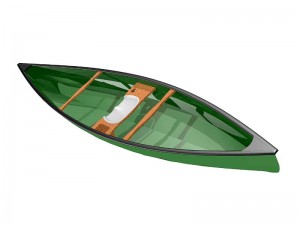 The hull shape is asymmetric in form with the widest point (and it’s center of buoyancy) just aft of the hulls’ midpoint. The hull also has decidedly enhanced rocker fore and aft when compared to traditional canoes of this size. These two design features give the boat very solid, straight-line tracking, as well as wonderful response to turning stroke input from the paddler.
The hull shape is asymmetric in form with the widest point (and it’s center of buoyancy) just aft of the hulls’ midpoint. The hull also has decidedly enhanced rocker fore and aft when compared to traditional canoes of this size. These two design features give the boat very solid, straight-line tracking, as well as wonderful response to turning stroke input from the paddler.
At full, 350-lb. displacement load, the Bighorn has just less than 8” of freeboard amidships. I don’t see this kind of load in this boat unless the owner is going out for a very long solo trip and needs to carry a lot of gear. More likely, you’ll be seeing an all-up, ready for trouble, load of around 290-300 pounds, depending on the weight of the paddler. I figure this boat can be built at right around 42 pounds, providing the guy with the resin doesn’t get too generous with the glue.
The seat setup in the renderings illustrates my take on an integrated unit recognizing the typical canoeists needs when out paddling. There’s a comfortable, sculptural sitting area much like the tractor-style seats one sees on the Wenonah canoes. It is coupled with an integrated pocket on one side for camera/binocular/etc. and on the other side… a circular, net bottomed opening to hold the beverage of your choice. (Ever had a can of coke tip over in your canoe while paddling because there was nowhere secure to hold it? Makes for a fun clean-up session, doesn’t it?)
If you don’t care for the integrated seating system, you can always use the traditional, woven caned seat, a simple, stretched canvas platform or a woven-webbing seat. For that matter, you could always buy a tractor seat from Wenonah.
Outside the typical description of a solo canoe introduction, I decided to include a little extra teaser for those so inclined. I drew a set of outriggers specifically for this boat.
They aren’t fancy in appearance, but they are very simple to build, easy to use and they provide enormous stability to the boat if you’d like to fish, shoot pictures, take a nap, shoot birds, etc. If you were so inclined, they can also be used with a modest sail rig to allow the Bighorn to be sailed like a trimaran, though don’t be expecting these amas, or the suggested sail rig size of 30 sq. ft., to provide much more than a pleasant sailing experience. Still, it could be fun on the right body of water.
Water Test Report by Stan Heeres
Build process documented along with the first trips out on the Boundary Waters Canoe Area
The complete web record of the Heres build is currently not available. I’ll search for it and locate what I can of the document.
Stan Heeres’ recent comments as follows:
“I purchased plans from you for the Big horn a few years ago. My son and I built the canoe and have since been on 2 Boundary Waters trips with it.
I promised you that I would detail the building process. I did and am just finishing the presentation up and will post it soon.
I have also built the John Winters Osprey (both the strip version and the plywood version). Here are a few details”
Strip Osprey
Lightest(34 lbs), receives the most comments by a wide margin (it looks really good), slowest of the 3 and hardest to keep in a straight line of the 3 at speed.
Plywood Osprey
2nd lightest lightest(36 lbs), very functional but does not get the comments, 2nd fastest and stays in a good straight line.
Big Horn
Heaviest(38 lbs), glides like a dream, Kevin, who uses it, will effortlessly pull away from the other canoes, tracks straight as an arrow.
It’s pretty clear that I am proud of the boat and how it has turned-out for an experienced canoe builder. Being able to say that one of my boats can effortlessly pull away from a design created by a known master in the trade is exciting. That it also has terrific tracking manners when loaded and out on serious water, really makes all the design considerations worthwhile. Stan, thanks so much for the really kind words on the boat. I’m really looking forward to Kevin’s report.
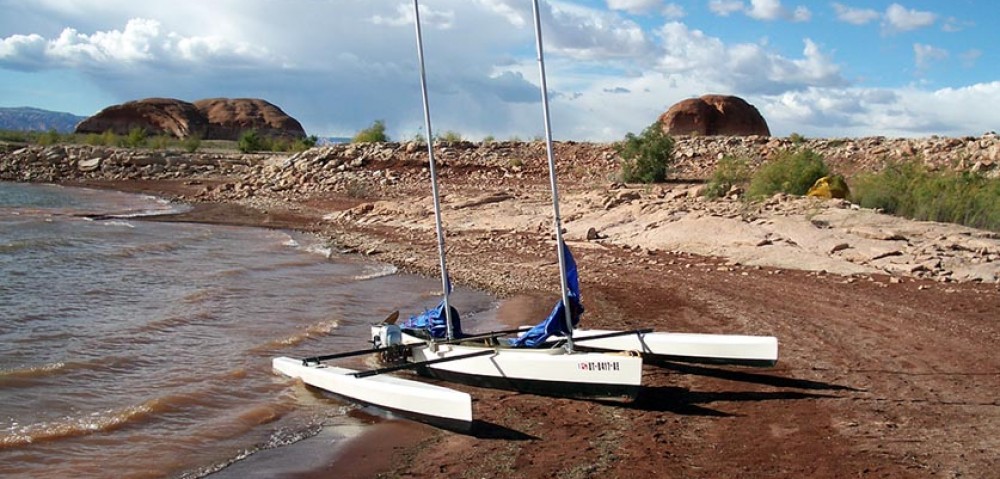
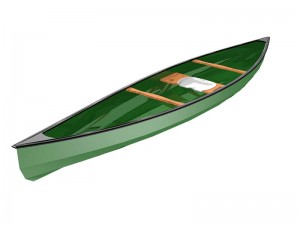
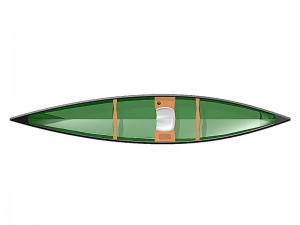
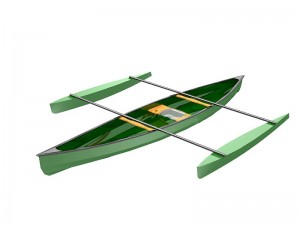



















 The Strider design calls for a very straight forward stitch and glue build method in 4mm marine plywood with glass/epoxy laminates inside and out. The twin Mirage trunks sit cleanly in the hull allowing for a comfortable seating arrangement for two persons and their day pedaling “stuff” such as binoculars, cameras, food, drink, blankets, etc.
The Strider design calls for a very straight forward stitch and glue build method in 4mm marine plywood with glass/epoxy laminates inside and out. The twin Mirage trunks sit cleanly in the hull allowing for a comfortable seating arrangement for two persons and their day pedaling “stuff” such as binoculars, cameras, food, drink, blankets, etc.